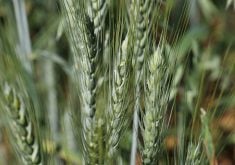Identify beneficial components | Researchers could use information to develop high efficiency feed for livestock and healthier food for humans
When George Katselis moves into his new laboratory at the end of the year, he’ll be looking for tiny molecules that could have big implications for the health of farmers and agricultural workers.
The Canadian Centre for Health and Safety in Agriculture’s National Agricultural-Industrial Hygiene Laboratory will be housed within a new expansion at the University of Saskatchewan’s College of Medicine, and Katselis will be leading its mass spectrometry research program.
“Think of mass spectrometry as a detection method,” said Katselis.
He’ll be using the tool to get a closer look at molecules and proteins, looking for tiny biomarkers that will help researchers understand how exposure to substances such as pesticides and dust can contribute to illnesses, including cancer.
Read Also

Defence investments could benefit agriculture
A bump in Canada’s NATO spending commitments could lead to infrastructure investments that would benefit rural areas
“This will help us for the development of vaccines and so on,” he said.
In this role, which is a first for the university, Katselis will be able to collaborate with researchers in other departments and organizations on campus, including the Vaccine and Infectious Disease Organization.
“With the College of Agriculture and Bioresources, there is potential. We can use mass spectrometry to identify lipids in various plants,” he said.
“It definitely can be used in plant and animal sciences. You can identify components of the food, for example.”
Across campus, the agriculture college is looking to fill a position in nutritional genomics, a first for the food and bioproduct sciences de-partment.
A new researcher in that position will examine the link between the food people eat, the nutrition they receive and their genetics.
“For our own department, it’s sort of a link between food production and food processing to individuals and individual health,” said Phyllis Shand, food and bioproduct sciences department head.
It’s hoped this research will help increase understanding of the role functional food and food components play in health and identify ways to improve those characteristics.
Collaboration with other college researchers could take several forms, including potential work to develop crops that contain increased levels of nutrients targeted to improve health and disease prevention or improve high-efficiency animal feeds.
Collaborations are also possible with Agriculture Canada officials and U of S researchers in animal and poultry sciences and the Western College of Veterinary Medicine.
An ad promoting the position says, “work in this area should lead to the development of new foods for optimum health and longevity and new opportunities for Canada’s agri-food sector.”
As a Tier II Canada Research Chair, the position will be funded with annual federal contributions of $100,000 for five years.
“It could relate to understanding better people with diabetes and the links to what foods that are available now that could improve their nutrition and health, but also it could relate to developing new foods or foods components that would add to someone’s health,” Shand said.














